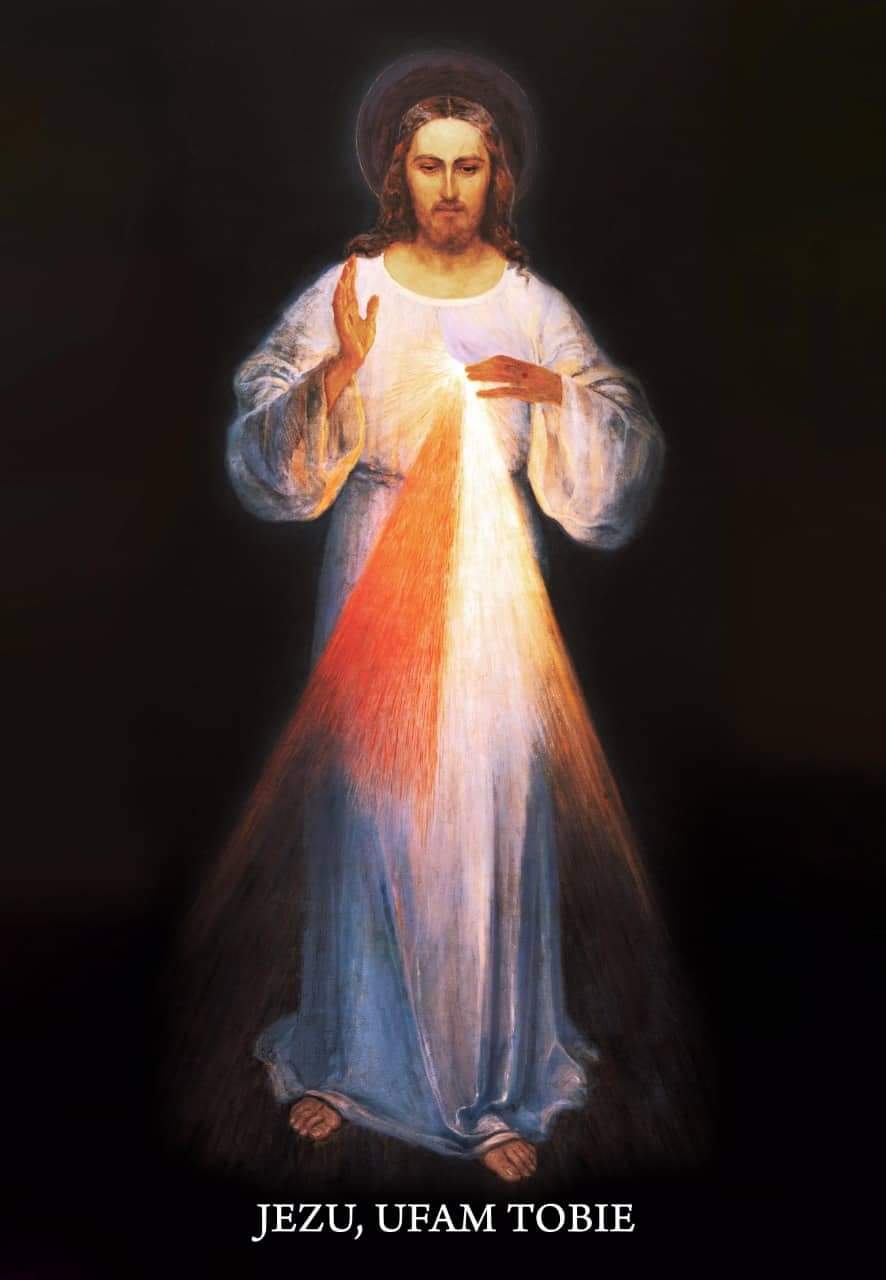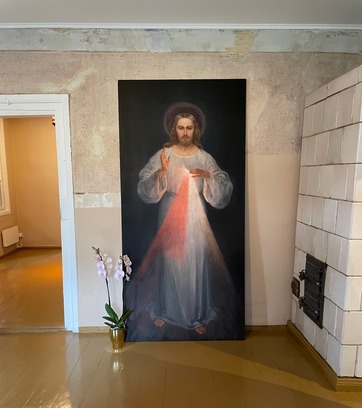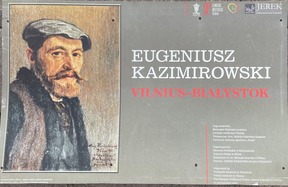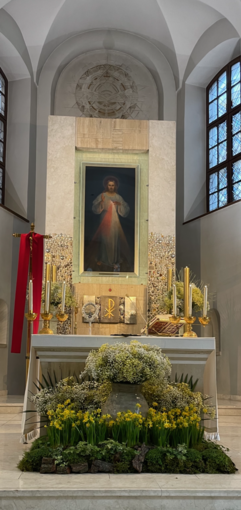April 28, 2022 By Michele Grantham
The Divine Mercy image is a painting of a vision of Jesus as he appeared in 1931 to a humble nun, St. Maria Faustina. This is a mystical image of the sacrifice of Jesus on the cross and the resurrected Jesus who visited the apostles in the upper room. St. Faustina describes the apparition in her diary:
“That evening when I was in my cell, I saw the Lord Jesus clothed in a white garment. One hand was raised in the gesture of blessing, the other was touching the garment at the breast. From beneath the garment, slightly drawn aside at the breast, there were emanating two large rays, one red, the other pale. In the silence I kept my gaze fixed on the Lord; my soul was struck with awe, but also with great joy. After a while, Jesus said to me, ‘Paint an image according to the pattern you see, with the signature: Jesus I trust in You. I desire that this image be venerated, first in your chapel, and then throughout the world. I promise that the soul that will venerate this image will not perish. I also promise victory over its enemies already here on earth, especially at the hour of death. I Myself will defend it as My own glory.’” (Diary, 47-48).


St. Faustina’s room where Jesus appeared.
Today, the original painting of this image is over the altar in a lovely small chapel in Vilnius, Lithuania. I was privileged to visit this image for Easter and Divine Mercy Sunday this past week. I visited several sites of Divine Mercy, including the convent where St. Faustina lived and experienced the visions and wrote her diary. For the past 500 years, Vilnius has displayed a large icon of the Mother of God, the Mother of Divine Mercy at the entrance gate to the city. How apropos that the original image of Divine Mercy also resides in this medieval city.
There are several painted images of the Divine Mercy by artists around the world. Part of the reason this occurred is because for many years due to wars or conquering armies, the original image went missing or was hidden for safe keeping. Artists were commissioned to paint the Divine Mercy image for the faithful based on St. Faustina’s diary or their own artistic expression. A very common version found around the world is by Adolph Hylo which was painted for the convent of Sisters of Our Lady of Mercy in Krakow, Poland where St. Faustina died.
The original painting of Divine Mercy was done by an artist named Eugene Kazimierowski, a realistic painter who was living and painting in Vilnius. St. Faustina who was assigned to a convent in Vilnius, supervised his work with the support of her spiritual advisor Father Michael Sopocko. All her apparitions except for one, took place in Lithuania. Because it was painted under the guidance of St. Faustina, this original painting is considered the most important in the history of the devotion of the Divine Mercy.

Convent in Vilnius

Artist – The image is to be a “vessel of graces” for people. The words of Jesus to St. Faustina are written in her diary:
This image is meant to be a source of the mercy and love of Christ, of comfort and hope, graces and miracles. The message of Divine Mercy is also a reminder that only the one who trusts in His mercy is open to receiving graces.
The original image has much to reveal to us. The background is black with a very soft hint of blue. Jesus is not standing on anything. His halo is purple. Jesus is stepping toward us. He is coming with His mercy. Thus, our response is to receive it for the purification of our souls.
Jesus instructed St. Faustina to make His gaze toward her, looking down, as if He were looking at her from the cross.
“My gaze from this Image is like My gaze from the cross.” (Diary 326).
Jesus is loving us personally from the cross. To meditate on the image of Jesus in the painting is to fall in love with our Lord whose gaze offers us union and communion with Him.

Chapel in Vilnius
The two rays of light coming from the heart of Jesus depict the blood and water that flowed from the side of Jesus when pierced by the lance. In the painting, the water is not purely pale or white but tinged by the blood. Sister St. Faustina heard these words from Jesus:
“The two rays denote Blood and Water. The pale ray stands for the Water which makes souls righteous. The red stands for the Blood which is the life of souls… These two rays issued forth from the very depths of My tender mercy when My agonized Heart was opened by a lance on the Cross. These rays shield souls from the wrath of My Father. Happy is the one who will dwell in their shelter, for the just hand of God shall not lay hold of him.” (Diary 299).
Three Sacraments are recognized in the Divine Mercy image. The water or pale ray signifies Baptism while the Blood represents the Eucharist. Baptism empowers us to love and show mercy to others despite our concupiscence or loss of sanctifying grace in Genesis 3. In the Eucharist we receive the Body and Blood of Jesus, thus, mercy itself resides within us. The third Sacrament is Reconciliation. The arm of Jesus is raised in blessing and forgiveness of our sins. We can ask Jesus to bless us, our family and friends, our country, and the whole world. Jesus is wearing a white robe with a cinch which signifies His priesthood. Those who study the original image often note that many copies of the Divine Mercy show the arm and hand of Jesus much higher than the traditional position for the blessing by the priest. St. Faustina was very meticulous in her description of the vision of Jesus. She would frequently visit the painter to critique the image. There are thirteen renditions of the blessing arm underneath the final image.
Fascinating studies have shown miraculous similarities in the face of the Divine Mercy Jesus and that of the Holy Shroud of Turin. A photographer mapped out the points of the faces in each image and found that they are an exact match. The Divine Mercy is a free hand painting, and it is impossible to match the shroud (Fr. Chris, TheDivineMercy.org).
Our world is in a lot of turmoil, and we all need the love and mercy of Our Savior Jesus Christ. Jesus said to St. Faustina:
“Humanity will not find peace until it turns with trust to Divine Mercy.” (Diary 300).
I encourage you to learn to pray the Divine Mercy Chaplet as a special devotion for our world.
Diary: Divine Mercy in My Soul, is the book based on the daily writings of St. Faustina. To obtain a copy of the original image, explore www.OriginalDivineMercy.com.
Courtesy : https://news.diocesetucson.org/


